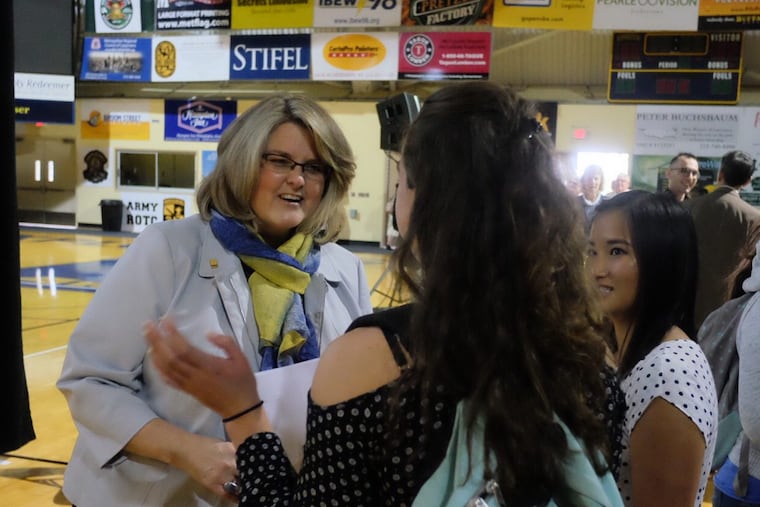La Salle president defends plans to sell art
Colleen M. Hanycz in a communication to alumni this week stated the university's case for pulling pieces of art from its museum for sale.

Despite mounting pressure to reverse course, La Salle University president Colleen M. Hanycz, in an email to alumni this week, defended the school's decision to sell 46 pieces of art to fund teaching and learning initiatives in its strategic plan.
"It will have a significant impact on advancing the student learning experience at La Salle," Hanycz said.
The university continues to get criticism over the decision from both on and off campus. National art museum groups have called it unethical to sell art and use the proceeds for anything other than the museum or its collection.
Also this week, art history faculty, in a letter circulated by their chair, said members were not consulted or informed of the decision to sell one-third of the works on display at the museum, "all of which we use daily for pedagogical purposes," and decried it as a violation of museum ethical standards and an affront to the museum's founder, Brother Daniel Burke, a former president of the Christian Brothers college.
"This sale breaks faith with … Burke's legacy, as well [as] the integrity of a critical component of our mission – to deepen students' ethical sensibilities," said the letter, signed by Susan Dixon, chair of the faculty.
Dixon in the letter called on the administration to work with faculty and staff on "an alternate solution" rather than risk "weakening our reputation in the community and our national standing as a civically engaged liberal arts institution."
William A. Price, chair of La Salle's chemistry and biochemistry department and head of the university's faculty senate, said he would like to see a forum held on the Philadelphia campus for faculty, staff, board members and students to discuss the matter. Reaction to the sale, he said, has been mixed and he expects to hear more when faculty and students return to campus for the spring semester later this month.
"I think I understand both sides," said Price, who has been at La Salle for three decades. "My heart is probably feeling it more than my head, and my heart says that this is devastating. I'm saddened by it. But I'm not in a position to make these decisions.…I'm not holding the purse strings."
Price said he hopes if the sale continues that a lot of the proceeds will be reinvested in the museum. The university estimates the sale could bring in between $4.8 million and $7.3 million.
Hanycz declined to be interviewed.
"We have no further comment on the deaccession," said spokeswoman Jaine Lucas.
The items to be sold include Dame Elisabeth Frink's sculpture Walking Madonna; Jean-Auguste-Dominique Ingres' Virgil Reading the Aeneid Before Augustus from 1865; Dorothea Tanning's Temptation of St. Anthony; Georges Rouault's Le Dernier Romantique (The Last Romantic); and Albert Gleizes' Man in the City (L'Homme Dans la Ville). They will be auctioned by Christie's this year.
Hancyz in her communication to alumni said precisely what the funds will cover will be decided in the coming months, but in general will support efforts around improvements to the library, a new freshman academic seminar program, and an institute for advanced teaching and learning.
The board of trustees, she said, believes allocating the sale proceeds for these initiatives "is an appropriate use that goes to the core of our mission in Lasallian higher education."
"We indeed owe a huge debt of gratitude to … Burke, whose vision and wise investment in art will allow us to both maintain a great teaching museum on campus and invest in an ambitious and visionary strategic plan as La Salle continues on its path to reclaim its prominence regionally, and become a recognized leader nationally for exceptional student outcomes."
The museum reopened this week with new items on display from the collection, which consists of close to 350 paintings, 65 sculptures, 500 drawings, 3,000 graphic prints, 175 photographs, and a few items of furniture and decorative art, according to the museum's website. The museum, in the lower level of Olney Hall in the heart of campus, will remain open and used for teaching, the university said.
Despite the controversy over the art sale, Price, the faculty senate president, said he understands that difficult decisions need to be made to help the university recover from a small freshman class a couple of years ago.
When Hanycz arrived in 2015 to lead La Salle, a Catholic university with 3,200 undergraduates, she was faced with a financial crunch. Freshmen enrollment had plummeted 18 percent, or 159 students, from the year before, and 23 staff members had to be laid off. The school faced a $12 million deficit in its $132 million budget.
Since then, the university has lowered its tuition sticker price, launched a marketing campaign, and announced plans to eliminate some programs, helping to offset the shortfall. She's also initiated partnerships with businesses and this week announced a dual enrollment agreement with the Philadelphia School District for students from two of the district's top magnet schools to take classes at La Salle this semester for free.
Faculty, Price said, generally have been supportive of Hanycz's efforts.
"Overall, I think people are pretty pleased with her," he said.